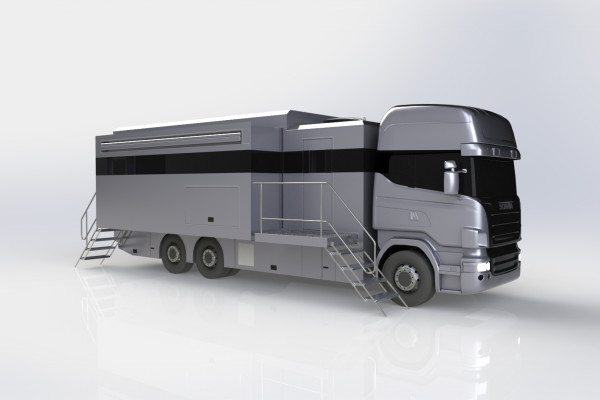
The new vehicle, which will be run by Northamptonshire Police and Northamptonshire Fire and Rescue Service (NFRS), will provide a base for commanders when in attendance at large scale or major incidents.
The tender for its construction has now been awarded to John Dennis Coachbuilders, Spectra Specialist Engineering Ltd and Excelerate Technology, who will work together to build and equip the unit.
The vehicle’s build is to be funded with a grant awarded by the Department for Communities and Local Government.
Group Commander Philip Pells, of the Joint Operations Team for Northamptonshire Police and Northamptonshire Fire and Rescue Service, said:
“The Joint Command Unit provides a unique command and control capability, enabling both fire and police officers to work together in a single vehicle. It also supports coordinated working with other agencies involved in an incident. This, together with the integration of resilient communications platforms and other technologies, enables the JCU to be the access point providing the highest level of situation awareness of an incident for all commanders and specialist responders, whether on scene or at a remote location.”
Superintendent Chris Hillery, of Northamptonshire Police, said:
“The Joint Command Unit (JCU) will further enhance emergency service response and service collaboration here in Northamptonshire. I very much look forward to making use of this vehicle with NFRS at live incidents across the county.”
 It is expected that the vehicle will be completed and officially launched in September 2016.
It is expected that the vehicle will be completed and officially launched in September 2016.
Its features will include:
- Joint working space for police and fire operations, including a Command Conference Room for joint tactical coordination.
- Ability to receive and view footage from remote deployable static cameras, body worn cameras, an unmanned aerial system and the police helicopter.
- Resilient communication technologies providing interoperability with EMAS Ambulance Hazardous Area Response Team command vehicles.
- Built on a Scania 26 tonne capacity chassis measuring 10.5 metres long, 3.85 metres high and 2.5 metres wide in transit mode but doubling in size with double expanding sides.
- Networks compatible with the Emergency Services Network (ESN) – the next generation system that will support voice communications, data and video sharing across the emergency services.
David Savage, CEO of Excelerate Technology (the organisation providing ICT integration and satellite communications for the unit) said:
“We are delighted to have been selected as technology partner on this strategically significant project, where we will be integrating the latest communications technologies to facilitate joint working, while enhancing operational efficiency and further supporting the resilience of the Northamptonshire incident response capability. With the government’s drive towards greater collaboration and sharing of resources across the emergency services, this new concept, ‘super’ Joint Command Unit is at the forefront of this transition.”
 Richard Hayes, Technical Sales Director at the specialist coachbuilding company, Spectra Specialist Engineering, said:
Richard Hayes, Technical Sales Director at the specialist coachbuilding company, Spectra Specialist Engineering, said:
“The vehicle is a ‘one-off’ and specifically designed for Northants as a joint command vehicle for fire and police. As far as I know there is no vehicle operating in the UK that has the same characteristics and operating capabilities as this one.
“Spectra will be using all our experience and knowledge gained through working with contrasting industries to enable us to deliver a high quality vehicle capable of exceeding all the demands set out by the client.”
Alan McClafferty, Managing Director at John Dennis Coachbuilders, said:
“We are extremely proud of the role we are playing in bringing this innovative vehicle into service. This new Joint Command Unit is state-of-the-art technology packaged in a vehicle which will significantly enhance the on-site management and control of major incidents for both Northamptonshire Fire and Rescue Service and Northamptonshire Police. It is also an excellent example of closer cooperation and shared effectiveness of emergency services.”






